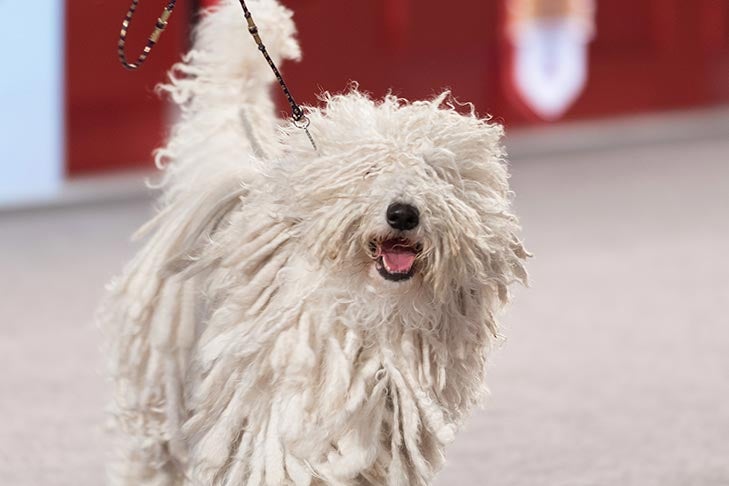
The Komondor is a beautiful, unique dog breed. The distinctive white corded coat of this member of the Working Group makes them particularly suited to their livestock guarding duties. Here are 7 Komondor facts and things to know about this Hungarian dog.
-
The Komondor Originated in Hungary
Originating in Hungary hundreds of years ago, the brave and muscular Komondor was bred for a purpose. Traditionally, their job was to guard flocks of sheep or other livestock from predators, such as wolves.

2. Their Coat Serves a Purpose
The Komondor’s white coat allows them to blend in with their charges during the day and be easily seen by the shepherd at night. The dense, corded coat also protects the Komondor from the elements and the bite of predators. The cords are open to the skin and allow air to flow through, but are very dense, so the coat acts as an insulator and a cooling mechanism.
3. Maintaining the Coat Requires Work
Weekly maintenance is essential to keeping the felt-like coat clean and attractive. Dirt can easily become trapped in the cords, so the best way to keep your Komondor clean is to prevent them from getting dirty in the first place. If all else fails, a good wash and grooming session should flush out any dirt.
4. Coat Texture Changes With Time
Komondor puppies are born with white, fluffy, and shaggy coats. The texture of the coat doesn’t change until a pup is around 8 to 12 months, when the coat begins to mat.

The initial mats will form large clumps. These need to be torn into smaller mats, which will form the beginning of the cords. The work required at this point is intensive, but will eventually result in beautiful cords. These early cords will be short, but over time the coat will grow longer until it reaches the ground when the dog is about 6 or 7 years old.
5. The Komondor Is a Large Breed
This is a large breed, with adult males standing at least 27.5 inches high at the top of the shoulder and females being at least 25.5 inches tall. In fact, there have been members of this breed as tall as 31 inches or more, although that is rare.
They’re happy to lie near their family, keeping watch over them. For exercise, consider giving them access to a fenced yard or be sure to take them for several walks each day.
6. Despite Their Size, They’re Agile
Considering their size, the Komondor is surprisingly quick and agile. Although usually calm, quiet, and extremely affectionate with their owners, if they perceive a threat to their territory, home, or family, they will leap to their defense, quite literally.

To drive away or knock down a potential predator, the large and powerful Komondor will leap toward it. This breed is an instinctive guardian and naturally protective of whatever he considers their flock. That makes proper socialization incredibly important.
7. They’re Very Smart
Komondors are smart dogs that can think for themselves. That can make training a challenge. The Komondor is easily bored and may decide once they’ve learned a new behavior, there is no reason to repeat it.
Especially considering their strength and guarding instincts, you need to have your Komondor under your control. Keep your training sessions upbeat and fun, and make sure your rules are consistent. They love to learn new things, so keeping your training fresh and full of surprises will keep them engaged.

